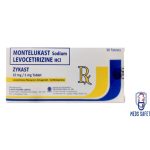Asmabron-N: Uses, Benefits, Dosage, Side Effects, Warnings

Asmabron-N is a combination medication classified as an “anti-allergic” or “anti-asthmatic.” It is primarily prescribed to alleviate the symptoms of asthma, a respiratory condition characterized by inflammation, airway narrowing, and the excessive production of mucus in the lungs and airways. These symptoms are often triggered by specific factors, including allergens, viruses, and physical activity. Asmabron-N’s unique formulation comprises two key active ingredients: Montelukast and Theophylline, each with distinct mechanisms of action.
- Montelukast: Montelukast is a leukotriene antagonist, which means it functions by blocking the action of leukotrienes, chemical messengers that play a pivotal role in promoting inflammation and swelling of the airways in the lungs. By inhibiting leukotriene activity, Montelukast reduces inflammation and constriction of the airways, making breathing easier and helping to prevent asthma attacks. Additionally, leukotrienes are released during allergic reactions, such as those triggered by dust or pollen. Montelukast can effectively reduce the levels of these inflammatory compounds, thereby mitigating symptoms.
- Theophylline: Theophylline operates by relaxing the smooth muscles surrounding the airways in the lungs. This relaxation results in the dilation of the airways, making it easier for the individual to breathe. Theophylline counters the constriction of the airways caused by substances released during asthma attacks, helping to maintain a more open and functional respiratory system.
Here are some key benefits of Asmabron-N:
1. Asthma Symptom Control: Asmabron-N is highly effective in controlling and alleviating the symptoms of asthma. Asthma is characterized by airway inflammation and constriction, leading to symptoms like breathlessness, wheezing, and coughing. Montelukast, one of the components of Asmabron-N, works by reducing inflammation and airway narrowing, making breathing easier and helping to prevent asthma attacks. This benefit is particularly important for individuals looking to lead an active and symptom-free life.
2. Allergy Management: Allergic reactions to various environmental triggers like dust, pollen, and allergens can lead to uncomfortable symptoms such as sneezing, itchiness, and a blocked nose. Asmabron-N, through its leukotriene-blocking action, helps reduce the levels of these inflammatory compounds, thus mitigating allergic reactions. This is particularly valuable for individuals with seasonal allergies who seek relief from symptoms like runny noses and itchy eyes.
3. Dual Mechanism of Action: The combination of Montelukast and Theophylline in Asmabron-N offers a dual mechanism of action. While Montelukast works to reduce inflammation and prevent airway narrowing, Theophylline relaxes the smooth muscles surrounding the airways, ensuring they remain open and functional. This dual action enhances the overall effectiveness of the medication in managing both asthma and allergic conditions.
4. Long-Term Use: Asmabron-N can be safely used for extended periods, as prescribed by your healthcare provider. This long-term use can be particularly beneficial for individuals with chronic asthma or recurrent allergies, as it allows for continuous symptom control and improved quality of life.
5. Improved Breathing: Theophylline’s muscle relaxation effect can lead to improved lung function and more comfortable breathing. This is especially advantageous for individuals who experience airway constriction and tightness as part of their asthma symptoms.
6. Symptom Prevention: Asmabron-N not only provides relief from existing symptoms but also helps prevent asthma attacks and allergic reactions. By reducing the levels of leukotrienes and keeping airways open, it serves as a preventive measure, ensuring that symptoms are less likely to occur in the first place.
How to Take Asmabron-N
To ensure the safe and effective use of Asmabron-N, patients are advised to adhere to certain guidelines:
• Dosage: Take Asmabron-N as prescribed by your healthcare provider. The dosage will be determined based on your specific medical condition.
• Administration: Swallow Asmabron-N whole with water; do not crush, break, or chew the tablets.
• Storage: Store Asmabron-N in a cool and dry place, away from direct sunlight.
Common Side Effects of Asmabron- N
Like many medications, Asmabron-N may lead to certain side effects in some patients. It’s important to understand that these side effects are not unusual and can occur as your body adjusts to the medication. While these effects might be bothersome, it’s essential to know how to manage them and when to seek medical advice. Below, we will delve into the common side effects associated with Asmabron-N and provide guidance on dealing with them:
1. Diarrhea: Diarrhea is a common side effect of Asmabron-N. It is characterized by loose, watery stools and increased bowel movements. To manage this side effect, it is advisable to stay hydrated by drinking plenty of fluids. Avoiding spicy and greasy foods can also help alleviate diarrhea. If it persists or becomes severe, consult your healthcare provider, as it may indicate an adverse reaction to the medication.
2. Headache: Headaches are another frequently reported side effect of Asmabron-N. These can range from mild discomfort to more severe pain. Over-the-counter pain relievers and getting adequate rest may help ease the headache. If the headache is persistent or severe, consult your healthcare provider for further guidance.
3. Abdominal Cramps: Abdominal cramps are characterized by pain or discomfort in the abdomen. They can be managed by lying down, taking slow, deep breaths, and applying a warm compress to the affected area. If the cramps persist or worsen, consult your healthcare provider for evaluation.
4. Flu-Like Symptoms: Some individuals may experience flu-like symptoms while taking Asmabron-N. These symptoms can include muscle aches, fatigue, and a general feeling of unwellness. Getting plenty of rest, staying hydrated, and taking over-the-counter cold and flu medications as advised by a healthcare provider can help alleviate these symptoms.
5. Nausea: Nausea is a sensation of discomfort in the stomach, often accompanied by an urge to vomit. Eating bland, easily digestible foods in smaller portions and taking Asmabron-N with a meal can help reduce nausea. If nausea persists or leads to vomiting, consult your healthcare provider.
6. Dizziness: Dizziness, a sensation of lightheadedness or unsteadiness, can occur with Asmabron-N use. It’s important to avoid sudden changes in position, such as standing up quickly, as this can worsen dizziness. Take your time when moving, and sit or lie down if you feel dizzy. If dizziness persists or affects your daily activities, consult your healthcare provider.
7. Vomiting: Vomiting is the forceful expulsion of stomach contents through the mouth. If you experience vomiting after taking Asmabron-N, it’s crucial to stay hydrated by drinking clear fluids and rehydrating solutions. Avoid solid foods until vomiting subsides. If vomiting continues for an extended period, seek medical attention to prevent dehydration.
While these common side effects may be bothersome, it’s essential to remember that not everyone will experience them, and they often subside as your body becomes accustomed to the medication. However, if any of these side effects persist, worsen, or if you develop severe or unusual symptoms, it is advisable to consult your healthcare provider. They can provide guidance, adjust your treatment plan, or explore alternative medications to ensure you receive the best possible management for your asthma or allergy symptoms.
Precautions and Warnings
While Asmabron-N can be an effective treatment for asthma, it’s essential to consider the following precautions and warnings:
• Allergies: Do not take Asmabron-N if you are allergic to Asmabron-N or any of its components.
• Mental Health: Asmabron-N can potentially lead to mood changes, including anxiety, aggressive behavior, irritability, restlessness, and even depression. If you experience any of these symptoms, inform your doctor.
• Liver Problems: Individuals with severe liver problems should exercise caution when using Asmabron-N.
• Alcohol and Antidepressants: Avoid simultaneous use of Asmabron-N with alcohol or other antidepressants, as it may reduce mental alertness.
• Discontinuation: Even if you are asymptomatic and feel well, do not stop taking Asmabron-N abruptly, as doing so may lead to an acute asthma attack.
Interactions with Other Medications
Asmabron-N may interact with various drugs, including painkillers, blood thinners, antiallergic medications, antiasthma drugs, antihypertensive medications, and anti-epilepsy medications. Inform your healthcare provider of all medications you are taking to ensure there are no adverse interactions.
Frequently Asked Questions (FAQs) About Asmabron-N
1. How does Asmabron-N work?
Asmabron-N is a combination of two medications: Montelukast and Theophylline. Montelukast is a leukotriene antagonist that operates by blocking the action of leukotrienes, chemical messengers responsible for promoting inflammation and swelling in the airways of the lungs. This action reduces inflammation, making it easier to breathe and preventing asthma attacks. Leukotrienes are also produced during allergic reactions to substances like dust or pollen. Asmabron-N helps lower the levels of leukotrienes, preventing the onset of symptoms. On the other hand, Theophylline functions by dilating the airways in the lungs, relaxing the surrounding muscles, and reducing the constriction caused by certain substances.
2. Can Asmabron-N cause mood changes?
While not very common, Asmabron-N can indeed lead to mood changes, which may include symptoms like anxiety, aggressive behavior, irritability, and restlessness. In some cases, individuals may also experience feelings of depression. It is important to inform your doctor if you notice any of these mood changes during your treatment.
3. How long can Asmabron-N be taken?
Asmabron-N can be safely taken for as long as your doctor has prescribed it to you. However, it is crucial not to discontinue or extend the duration of your treatment without first consulting your physician. Your doctor will determine the appropriate treatment duration based on your specific medical condition.
4. Does Asmabron-N cause drowsiness?
Asmabron-N typically does not induce drowsiness, but in some instances, drowsiness and sleepiness have been reported. Therefore, it is advisable to take the medication in the evening or at bedtime to minimize any potential impact on alertness.
5. I was diagnosed with depression, can I use Asmabron-N?
Therapy involving leukotriene receptor antagonists like Montelukast may worsen symptoms related to psychotic events in individuals with a history of mental illness. Careful administration and monitoring are essential for individuals with neuropsychiatric disorders before taking Asmabron-N. If you have been diagnosed with or have a history of mental illnesses such as depression or seizures, it is imperative to consult your doctor before starting Asmabron-N to ensure your treatment is safe and appropriate for your specific condition.





